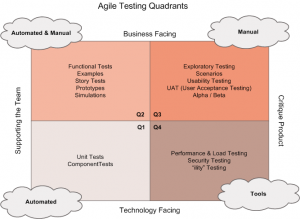Whilst digging into the test matrix / agile quadrants, I’ve come across several different representations of the model.
This post is a collection of some of those representations (in chronological order as far as I can tell).
Click on the image to find out more information.
Brian Marick (2003)
Mary & Tom Poppenieck (2006/2008 ?)
Lisa Crispin & Janet Gregory (2008)
Elizabeth Hendrickson (2012)
Gojko Adzic (2013)
Anne-Marie Charrett (2014)
Duncan Nisbet & James Bach (2014)
You will notice similar patterns to the others, with a few exceptions. Other models have the “-ilities” type tests in the bottom right hand quadrant. This doesn’t work for me.
In the web context where I predominantly work, KPIs like page loading/response times, site uptime & peak loads of traffic are very much in the Business interest, not just the developers on the team.
I’ve included load / performance tests in the TR quadrant because in my experience there has been a lot of experimentation with different loads of traffic (&/or content) & performance tweaks. As an example, once a page loading time threshold has been set, the check becomes the benchmark & shifts to the TL quadrant as a change detector to alert if the site is slowing down
***UPDATE***
Bach & Bolton (2014) have added their voice to the Agile testing quadrants discussion. I like how they build their model up of several layers with different representations of dynamics. Goes to show that in every model there’s more information than is actually displayed
Here’s the RST Agile Ecosystem v1.0:
James Bach & Michael Bolton (2014)
Image courtesy of Michael Bolton, taken from his EuroSTAR presentation
James talks about the quadrants at Oredev
Michael talks about the quadrants at EuroSTAR
Next posts:
Post 5: Example usage of the matrix
Post 6: Wrap Up
Previous posts:
Post 1: Intro
Post 2: Rectangles
Post 3: Columns

